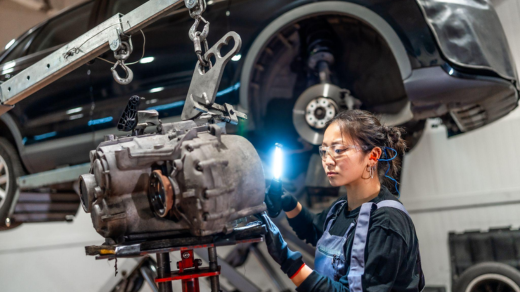The All-Wheel Drive Philosophy
Subaru’s unique approach to vehicle design, centered around all-wheel drive and horizontally opposed engines, required developing transmissions unlike any others in the automotive industry. This distinctive philosophy has produced gearboxes that excel in conditions where conventional transmissions struggle, earning Subaru a devoted following among enthusiasts who value capability and reliability. From rally-bred manual transmissions to sophisticated continuously variable transmissions, Subaru’s gearbox development showcases innovative solutions to unique engineering challenges.
The foundation of Subaru transmission design lies in their commitment to symmetrical all-wheel drive. Unlike manufacturers who adapt front-wheel-drive platforms for occasional all-wheel capability, Subaru engineers designed their transmissions from the outset to distribute power to all four wheels efficiently. This fundamental difference results in superior balance, predictable handling, and exceptional traction that defines the Subaru driving experience.
Early Development and Design
Early Subaru transmissions established patterns that continue today. The integration with horizontally opposed engines created packaging advantages, allowing for lower centers of gravity and better weight distribution. Manual transmissions featured robust synchronizers and gear sets capable of handling the unique stresses of all-wheel drive operation. These early designs proved remarkably durable, with many surviving decades of use in challenging conditions.
The development of Subaru’s rally programs profoundly influenced transmission evolution. Competition in the World Rally Championship demanded gearboxes capable of surviving brutal conditions while delivering precise control. Technologies developed for works rally cars, including strengthened casings, improved synchronizers, and sophisticated differentials, eventually appeared in production vehicles. This racing heritage gives Subaru transmissions a competitive edge in durability and performance.
JDM Transmission Advantages
For enthusiasts seeking proven reliability and performance, affordable JDM Subaru transmissions offer excellent value propositions. Japanese domestic market transmissions often featured closer gear ratios and stronger components compared to other markets. These differences make JDM transmissions particularly attractive for those building project cars or seeking to enhance their vehicle’s performance characteristics while maintaining factory engineering standards.
The STI six-speed transmission represents the pinnacle of Subaru manual gearbox development. Designed to handle the substantial torque of turbocharged engines while managing sophisticated all-wheel-drive systems, this transmission became legendary among enthusiasts. Features like front and rear limited-slip differentials, driver-controlled center differential, and incredibly strong internals create a transmission capable of handling significant power increases while maintaining daily usability.
Automatic Transmission Evolution
Subaru’s automatic transmission development took unique paths compared to conventional manufacturers. Rather than simply adapting existing designs, Subaru created automatics specifically for all-wheel drive applications. The four-speed and later five-speed automatics featured robust construction and programming optimized for varying traction conditions. While perhaps not as sporting as manuals, these automatics proved remarkably capable and durable in real-world use.
The introduction of Lineartronic CVT (Continuously Variable Transmission) technology marked a significant advancement for Subaru. Unlike traditional CVTs that often feel disconnected and uninspiring, Subaru’s implementation maintains driver engagement through simulated gear steps and responsive programming. The chain-driven design provides durability superior to belt-driven alternatives, addressing common CVT reliability concerns. This technology allows optimal engine operation for efficiency while maintaining the all-wheel-drive capability Subaru customers expect.
Maintenance Requirements
Maintenance requirements for Subaru transmissions reflect their unique design challenges. All-wheel drive systems place additional stresses on transmissions, making proper fluid maintenance crucial. Different models require specific fluid types, and mixing incompatible fluids can cause expensive damage. However, when maintained correctly, Subaru transmissions routinely achieve impressive mileage, with many examples exceeding 200,000 miles of reliable service.
The manual transmission options in performance Subaru models deserve special recognition. The five-speed transmissions in WRX models provided an excellent balance of strength and weight, handling substantial power while maintaining reasonable fuel economy. The characteristic notchy shift feel, while different from other manufacturers, provides positive engagement that many drivers prefer. These transmissions respond well to modifications like short-shift kits and upgraded bushings.
Advanced Differential Systems
Subaru’s approach to limited-slip differentials sets their transmissions apart. Various systems, from viscous coupling units to electronically controlled differentials, provide traction advantages in challenging conditions. The Driver Controlled Center Differential (DCCD) in STI models allows drivers to adjust power distribution based on conditions, providing unprecedented control over vehicle dynamics. This technology showcases Subaru’s commitment to giving drivers tools for maximum performance.
The aftermarket support for Subaru transmissions remains robust, with specialists offering everything from basic rebuilds to competition-spec preparations. The popularity of Subaru vehicles in motorsports ensures continuous development of upgrade parts. From strengthened gear sets to advanced differential options, enthusiasts can build transmissions suited to specific needs. This support network makes owning and modifying Subaru transmissions more accessible than ever.
Environmental Considerations
Environmental considerations influenced recent Subaru transmission development significantly. The Lineartronic CVT contributes to impressive fuel economy improvements while maintaining all-wheel-drive capability. Even manual transmissions benefit from optimized gear ratios that balance performance with efficiency. These developments help Subaru meet stringent emissions requirements without sacrificing the capability their customers expect.
The future of Subaru transmissions continues evolving with new technologies while maintaining core strengths. Development of hybrid systems that integrate with all-wheel drive showcases Subaru’s ability to adapt while preserving their unique character. The continued availability of manual transmissions in performance models demonstrates commitment to enthusiast preferences, ensuring driving engagement remains a priority.
Conclusion
In summary, Subaru transmissions represent unique solutions to distinctive engineering challenges. The combination of all-wheel drive capability, rally-proven durability, and innovative technology creates gearboxes unlike any others available. Whether navigating challenging weather, enjoying spirited driving, or competing in motorsports, Subaru transmissions provide the capability and reliability that define the brand. Their continued development and strong aftermarket support ensure these exceptional transmissions will serve enthusiasts well into the future, maintaining Subaru’s reputation for building vehicles that excel where others fear to tread.




